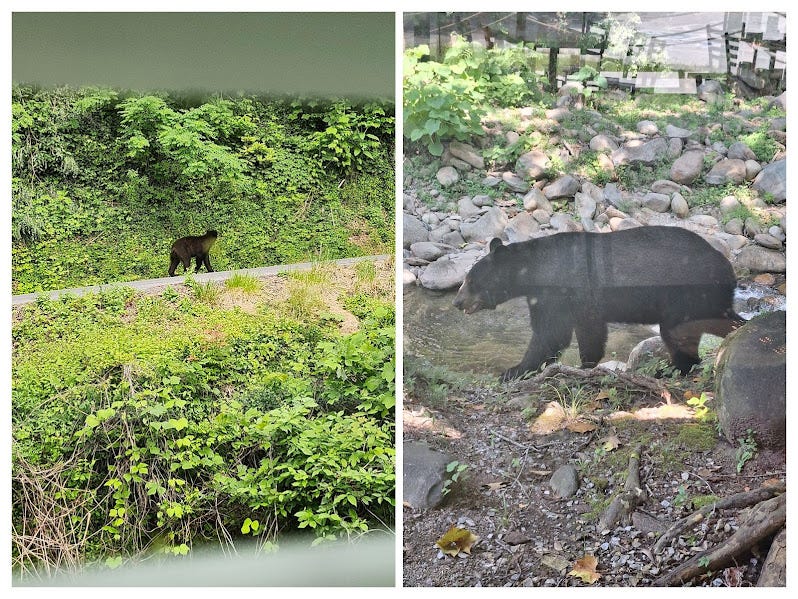Are There Bears Everywhere in Gatlinburg?
An overview of the issues in the past year with bear encounters and how humans can do better to ease the problem.
Millions of people come to the Gatlinburg and the Smoky Mountains every year, and many of them want to know where they can see bears. Recently, it’s been hard not to notice how prevalent the sightings have been. This is by no means meant to discourage anyone from visiting who doesn’t want to see one. I believe there are legitimate reasons why there has been an increase in the encounters. I am going to mostly cede to the experts and the facts of the matter with a few opinions sprinkled in, so let’s get started.
First of all, even though this is anecdotal, many locals who have been here longer than I have, are pretty vocal about the voluminous, unprecedented number of bears they have seen in the past year. Sure, more people than ever before have their phones out, but our eyes aren’t deceiving us. The Gatlinburg P.D. has also seen an increase in calls, but more awareness is likely for the spike. I certainly didn’t expect to have written this many posts about bears, but living here gives it an added importance to the issue.
I feel like I’ve been pretty fair on this situation. The problem is without question humans. Many locals would love to point the finger at tourists, since there are so many of them, but the locals have to share at least a good portion of the blame. While I applaud the City of Gatlinburg for making strides to help with the problem, people have—and likely still do in certain areas—been lazy and neglectful for decades, taking things for granted as far as safety and awareness is concerned.
As we speed toward the fall season, we are possibly going to see even more bears in Gatlinburg. They will begin to collect more food for their hyperphagia period, where they will be after excessive quantities in preparation for their hibernation. This may spell more interactions, which I hope doesn’t lead to a strain on what limited resources we have for the precious bear cubs.
The Appalachian Bear Rescue has been wonderful in taking in orphaned cubs, either due to a car accident or euthanization, instead of the lack of food for the young ones. That was their main matter of concern at first. Because of these recent problems, they have taken 31 in the past year. I am not sure what their limitations are, but I’m sure they would love not to see more bears come in because humans were being careless. When people do any number of leaving food out, trash unsecured, doors unlocked, they’re inviting problems. Once bears—and many have—lose their fear of humans, it’s only a matter of time before something bad happens.
These bears have seemingly increased in number, and another surprising fact is they are now known to be extremely mobile creatures. At one time, the idea was long understood they stayed in a general area, but we now know that is not the case. The amount of bears in the Great Smoky Mountains National Park, while recorded as 1,909 in 2020, is likely a low estimate of the actual number, according to Ryan Williamson, wildlife biologist for the park. My thoughts? I would say he’s right, and I believe it’s well over 2,000. I don’t know how much better they can record it, other than measuring “hair snares” on barbed wire, but again, I’m no expert or scientist.
Even though we’re never going to be 100% compliant, the awareness in the present day has never been higher, and we are going to hope the education, brochures, and signs will help people understand the simple rule: “a fed bear is a dead bear.” I care about this more than ever before, and I hope you’ll keep spreading the word as I write more about this issue. I would love to have positive news the next time I put out another post on bear safety and awareness—which will not be ignored.
To conclude, it’s not like there are dozens of bears roaming the streets of the tourist town at any given time during the day or night; that’s not true. However, the chances are good you’ll see one, so be vigilant, and don’t try to get close and approach if you spot a bear. We all know there is always that one person who tries to get close, then a whole group will all succumb to peer pressure and do the same. Please…don’t! It’s not worth your life or the bear’s to get the best shot. They are mainly docile creatures, but if you invade their personal space at the right time, they are known to bluff charge. You don’t want to test whether they are bluffing or not. It’s an aggressive move to keep you the hell away, so please behave.
Thank you for reading this post on my publication. I hope you can help spread the word by sharing this with others, even if it means by word of mouth. It is extremely important we keep all animals—including humans—safe from unwanted encounters that have plagued the area in recent times. I appreciate it, and please stay tuned!





We have a condo in hidden Hills and since I came up on Tuesday, have encountered four bears. Now I am not stupid thinking I can outrun a bear so I just backtrack to my condo😊